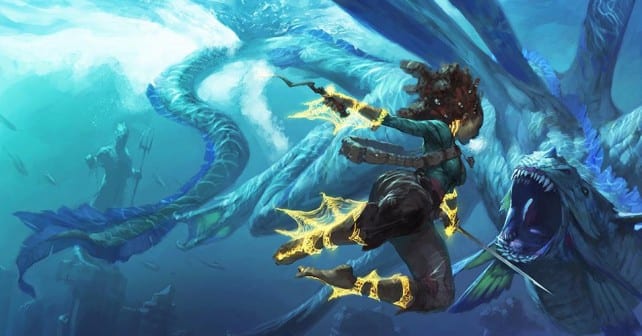
After reading through Ghosts of Saltmarsh, I ended up watching several Nova specials that included an emphasis on underwater exploration and it got me thinking about how it tends to be underrepresented in a lot of DND campaigns. I’m not sure if it’s just because it’s such an alien concept to a people that cannot survive the depths of the ocean without special equipment or if it’s simply the fact that players aren’t aware of the rules. But in doing some research for this article, I made myself familiar with those rules again and was pleasantly surprised to find that, much like the rest of the game, they are actually quite simple. But instead of going through them at length here, I will point you to the excellent Dungeon Solvers which gives a great breakdown of the mechanics of fighting underwater.
These rules assume that your character has some means of breathing underwater – if that’s not the case, then you need to keep in mind the rules for holding your breath located on page 183 of the Players Handbook. Put simply you can hold your breath for a number of minutes equal to 1 + your Constitution modifier (with a minimum length of 30 seconds). After that point, you have an additional number of rounds equal to your Constitution modifier before you need to breathe or you drop to 0 hit points and begin dying.
Now there are a few spells and magical items that allow for an easier time exploring underwater, but they aren’t typical fare for low-level characters. With that in mind, I wanted to take a stab at creating a feat that would allow a character some greater versatility underwater without magical aid. Taking some inspiration from the Abendago Diver ranger archetype from Pathfinder, I came up with the first draft of a feat that would be useful for modeling such a character.
Deep Diver
Through years of practice, you are highly skilled at diving deep underwater without magical aid. You gain the following benefits:
- Increase your Constitution score by 1, to a maximum of 20.
- You can hold your breath for double the normal amount (1 + Constitution modifier minutes) of time before you are at risk for suffocating or drowning.
- You gain advantage on Athletics checks made to navigate obstacles or rough terrain while you are underwater.
But it doesn’t have to stop there – just as we use equipment in order to increase our odds of survival whenever we explore underwater, there are a couple of pieces of equipment that can be translated into a Dungeons and Dragons game.
Flippers: This footwear, while bulky and ungainly on land, is made to help a user propel themselves through the water with greater ease. When wearing them, movement underwater is no longer considered to be difficult terrain for you. However, movement overland costs you 1 extra foot of movement (or 2 extra feet in difficult terrain). Putting on or taking off a pair of flippers is a full-round action. Cost: 2 gp.
Snorkel: Designed to allow a character to swim shallow depths without the need to surface for air, this item has little usage in water deeper than an adult human. As long as the character is within 5 feet of the surface of water, they don’t have to hold their breath to remain underwater. Cost: 5 sp.
Flotation Device: The most basic of these devices is a simple sack of a light material that can be inflated and then either strapped to the body or held onto to keep someone afloat until rescue arrives. Inflating such a device takes 3 rounds and provides 10 minutes of buoyancy before it deflates. Due to the stress placed on the material, each flotation device can only be used once. More advanced versions of this device use alchemical reagents stored inside to inflate it automatically instead. Activating this kind of flotation device takes a single action. Cost: 5 cp, or 5 gp for the automatic version.
Now comes the question, what class options are able to make good use of underwater environments? There are a few that come to mind right off the bat.
Path of the Storm Herald Barbarian – This character path gets access to a swim speed at 6th level with the Sea option in the Storm Soul ability. As a barbarian, your natural Strength and Constitution also make sure you can navigate the roughest waters and hold your breath for longer.
Circle of the Land Druid – Specifically the Coastal druid is great for a character that wants to explore underwater. Their circle spells grant them access to spells like water breathing, control water, and freedom of movement, which can help out an entire party. Furthermore, starting at 4th level, the druid is able to wild shape into a creature that has a swim speed. The Circle of the Moon class option does give you access to more powerful underwater forms such as sharks, but at the cost of some very useful circle spells.
Ranger – Unlike the previous two, there really isn’t a standout Ranger path, but their Natural Explorer class features makes them naturals at leading a group near water environments. I would be hard pressed to not let these bonuses extend to actually being underwater as long as they are within sight of the coast. Favored Enemy also lets you choose some of the more common underwater creatures such as sahuagin or merfolk.
Transmutation Wizard – Many of the great spells that help affect a character underwater are part of the transmutation school – control water, water breathing, and water walk. What’s more this school of magic gets the ability to cast the polymorph spell on themselves once per day for free at 10th level into a form of CR 1 or lower – perfect for getting access to a swim speed.
